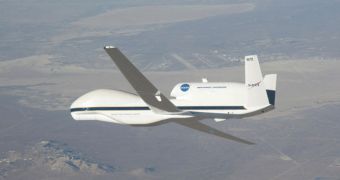Officials at the American space agency are proud to announce the successful completion of the first science flight to be performed by a large unmanned aerial vehicle (UAV). Using one of its two Global Hawk aircraft, scientists at NASA managed to conduct the first long-duration, high-altitude flight above the Pacific Ocean, collecting a wealth of scientific data in the process. Generally, Global Hawks are used for reconnaissance and monitoring missions by the military, and this is the first instance in which it was converted to civilian applications.
Throughout April, the Global Hawk Pacific (GloPac) mission was scheduled to perform five flights. With the successful completion of the first one, only four others remain, but the program will most likely extend in the future as well. The goal of the initiative is to study traits related to Earth's atmosphere, and to the interactions of its components, above the Pacific and Arctic oceans, experts at the NASA Jet Propulsion Laboratory (JPL) in Pasadena, California, report on their official website.
“The Global Hawk is a revolutionary aircraft for science because of its enormous range and endurance. No other science platform provides the range and time to sample rapidly evolving atmospheric phenomena. This mission is our first opportunity to demonstrate the unique capabilities of this plane, while gathering atmospheric data in a region that is poorly sampled,” says GloPac co-mission scientist Paul Newman. He also holds an appointment at the NASA Goddard Space Flight Center (GSFC) in Greenbelt, Maryland, where he is an atmospheric scientist.
The first science flight took place this Wednesday, and lasted for about 14 hours. The Global Hawk UAV flew for about 8,334 kilometers (4,500 nautical miles) non-stop, collecting readings with the vast array of instruments it has on board. During the flight, it reached an altitude of 18,562 meters (60,900 feet), which is about twice as high than commercial airliners. The flight was controlled from the NASA Dryden Flight Research Center, in the Mojave Desert, California.
“The Global Hawk is a fantastic platform because it gives us expanded access to the atmosphere beyond what we have with piloted aircraft. We can go to regions we couldn't reach or go to previously explored regions and study them for extended periods that are impossible with conventional planes,” concludes GloPac co-mission scientist David Fahey, who is also a research physicist at the Boulder, Colorado-based Earth System Research Laboratory. The facility belongs to the US National Oceanic and Atmospheric Administration (NOAA).

 14 DAY TRIAL //
14 DAY TRIAL //